Letters
Reprinted from "Crown Jewels of the Wire", July 2002, page 6
AFGHANISTAN SUPPLIED WITH RUSSIAN MADE INSULATORS
My brother recently returned from Afghanistan where he covered the war for
seven months for the New York Times. He brought back two glass insulators from
Kabul, and I thought you might like to see them. Feel free to include this in
your magazine. I thought your readers might find it interesting.
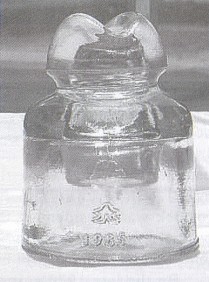
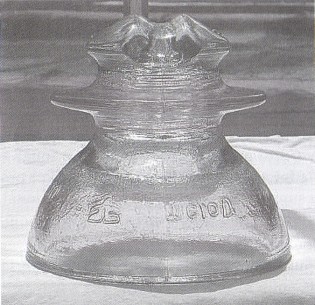
As a collector of insulators, I am always after my brother to bring some back
from his world travels. He finally delivered with what I call these "spoils
of war." :-)
I attach photos of the insulators. Both are Soviet made and
date from the Soviet era in Afghanistan. Both are a light apple green in color.
The large insulator dates from 1990 and is embossed with what appears to be
Cyrillic characters that I can't read. With respect to the large insulator, the
embossing is on the inside of the skirt, which is something I have never seen
before. Its pin hole is wider than a North American pinhole. The small insulator
is dated 1985 and the embossing is on the outside of its skirt. It has a narrow
pinhole.
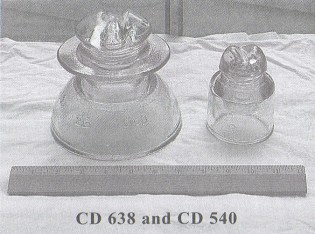
Insulator collecting is very dangerous in Afghanistan. My brother,
Dexter Filkins, has been to Afghanistan many times over the past four years but
was never able to get any glass insulators until this year. He has seen many
downed poles brimming with insulators, but because of land mines, he could never leave the
roadways to retrieve them.
These two insulators were recovered from a warehouse
in Kabul where they were being stored. Reportedly, the Taliban smashed nearly
all of the glass insulators in storage, and there were only a few left when my
brother found them. Dexter speculated that the Taliban smashed the insulators
thinking that they were small statutes and thus possibly sacrilegious.
Fortunately, these two escaped that fate. Dexter returned to the U.S. last week
and gave them to me. He said that the Afghans thought he was a nut for wanting
them. :-)
I took the photos a couple of days ago in my apartment in New York.
Rick Filkins,
Cape Canaveral, Florida
CRYOLITE
In the June 2002 CJ issue, there was a question posed about "cryolite
", and its use regarding insulators. A request for a chemist s help was
printed in hopes of identifying this compound as being either porcelain or
ceramic. I am a medical technologist working in a clinical chemistry setting and
I was able to find a little information for you, however, a geologist would be
your best bet for the most detailed explanation.
Cryolite (Na3IF6) A white or colorless material that
crystallizes in the
monoclinic system but has a pseudocubic aspect; found in masses of waxy luster;
hardness is 2.5 on the Mohs Scale, and specific gravity is 2.9 to 3.0; used
chiefly as a flux in producing aluminum from bauxite and for making salts of
sodium and aluminum and porcelaneous glass. Also know as Greenland Spar or Ice
Stone. (McGraw Hill Scientific Dictionary)
The Mohs Scale is defined as:
"An empirical scale consisting of ten minerals with reference to which the
hardness of all other minerals is measured. It includes from softest (designated
1) to hardest (10) talc, gypsum, calcite, fluorite, apatite, orthoclase;
quartz, topaz, corundum and diamond. "
Lisa McHugh, MT (ASCP),
Leominster,
MA
HEMINGRAY SPIRITS
Well, this isn't the "find" of the year, but to me it's a little
too coincidental not to mention.
I've collected insulators for about 25 years,
go-withs for about 6 or 7 years, been a "Crown Jewels of the Wire"
subscriber and NIA member for almost 20 years. Due to digging at the Hemingray
Muncie plant plus picking up Hemingray and other insulator manufacturer's
products for the last several years, I have found I need to add on to the house.
(I have a small house to begin with.) I built a 24' x 24' garage a few years
ago, so I have good storage area to keep Hemingray dump stuff in and a nice work
area.
Now, as far as adding to the house, I'm preparing the yard before the
contractors begin, like removing and transplanting sod, taking out a fence, etc.
This house was built in 1950, was added to in the 1960's and was part of a large
family farm until I bought it in 1985. I've filled it up with insulators and
go-withs, so the hobby dictates that I put on more room.
My spare bedroom is
where the insulators and some go-withs are, and that side of the house is where
two rooms will be added. On March 8 I'm almost done moving sod, and going down
about a foot to remove old rotting tree roots when I hear a "clink" in my shovel.
I take the sod remains and dirt off whatever is below on the shovel to reveal a
CD 113 Hemingray 12, blue aqua, sharp drip points, patent date!
It was a foot
down in the ground, and three feet from the insulator room! So, not a great
find, but after digging at Hemingray and tossing them aside at the plant, I
think I'm going to save this one. This is one area of the yard I've barely
touched with a shovel and even with water and gas lines recently installed down my road and to the house, not one
bit of an insulator has been dug up.
Hemingray insulators were the first
insulators I collected and remain my favorites, especially now with the
Hemingray plant diggings, and the weekend of my birthday, digging out in my
yard, by the "insulator room", Hemingray spirits are going to make
sure I keep them as my number one company.
Roger Lucas,
Columbus, Indiana
ICE - NOT NICE
Gerald Miller of Jacksonville, MO sent photos of a January ice storm that hit
the midwestern states. His 37 year tour of duty as a lineman for SW Bell duty is
over, so he understands the problems that face the utilities following this
icing. Look at his backyard display of suspension disks!
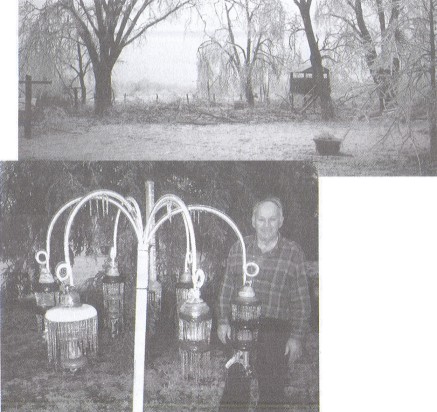
INTERIOR DECORATING WITH MULTIPLE CENTURIES OF COLLECTIBLES --
Cal Baker, Conyers, GA recently visited a friend who used a myriad of
vintage
collectibles in her home -- a telegraph key, crank wall phone, brass weights for
scales, wooden spindles for thread, a two piece transposition insulator on a
side pin -- all right above a stack of CD-roms!
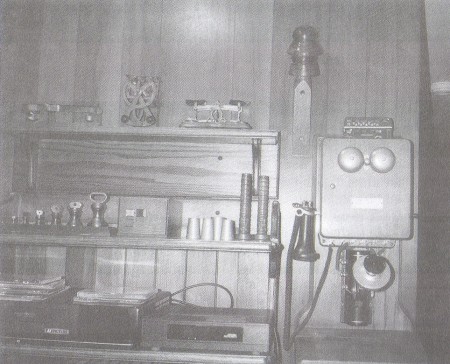
And, I liked the two side pins with beehive insulators used as towel racks in
the bathroom, along with bottles, plants, minerals and a porcelain vase!

| 